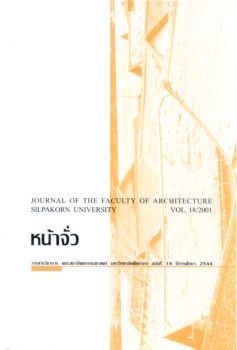แนวคิดใหม่เกี่ยวกับการศึกษาวิจัยเรื่องสภาวะสบาย
Abstract
การศึกษาวิจัยเรื่องสภาวะสบาย (Thermal Comfort) นั้นก็เพื่อที่จะค้นหาสภาวะที่คนส่วนใหญ่มีความรู้สึกพอใจกับสภาพอากาศนั้นๆ ไม่หนาวหรือไม่ร้อนจนเกินไป นั่นก็คือ อุณหภูมิที่เป็นกลาง (Neutral Temperature) ซึ่งเป็นปัจจัยหลักและปัจจัยแรกที่นํามาพิจารณา แต่เดิมนั้นสภาวะสบายจะถูกจํากัดอยู่ในช่วงของสภาพอากาศหนึ่งๆ (Comfort zone) ซึ่งเห็นได้จากทั้ง Bocimatic chart โดย Olayay (1963) และ Building Bocimatic Chart โดย Givoni (1969) ทั้ง 2 แผนภูมินี้เป็นผลที่ได้มาจากการค้นคว้าวิจัยในห้องทดลองที่มีสภาพอากาศที่นิ่ง (Steady-State) ซึ่งแตกต่างไปจากสภาพอากาศที่เป็นจริงในสิ่งแวดล้อมที่มีลักษณะเปลี่ยนแปลงอยู่ตลอดเวลา (Transient Condition) แนวคิดใหม่ในการศึกษาวิจัยเรื่องสภาวะสบาย จึงควรที่จะเพิ่มเติมเนื้อหาทางด้านระบบพลวัตของสิ่งแวดล้อมรวมทั้งการยอมรับสภาวะสบายทางจิตใจของบุคคลในสังคมนั้นๆ ด้วย
New Concept on Thermal Comfort Research
Research on thermal comfort aims to establish the condition that the majority of people satisfy with their environment, feeling neither too cold nor too hot. This condition is at neutral temperature and defines within a range of comfort zone. The classic study of thermal comfort concludes into Bioclimatic Chart proposed by Olayay (1963) and later developed into Building Bioclimatic Chart by Givoni (1969). Both charts are the products derived from research in steadstate condition, where is different from the actual environment-transient condition. A new concept on thermal comfort research proposes to add more information, considering the dynamism of environment and the acceptance of psychological comfort of human beings.





